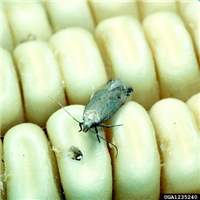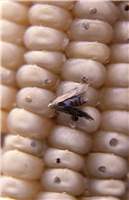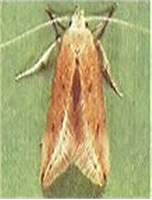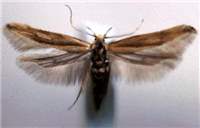Click on images to enlarge

Angoumois grain moth. ©Clemson University, Bugwood.org. www.ipmimages.org

Damage symptoms on maize infested by Angoumois grain moth. Image from Maize Doctor, CIMMYT

Adult Angoumois grain moth. Photo: USDA, ARS (Public Domain)

Adult Angoumois grain moth set specimen. ©Mark Cook (source CABI CPC)
Summary
The grain moth is found throughout the warmer parts of the world. It is a pest of stored maize and a very broad range of other stored products. The grain moth has a very broad host range. The larvae (caterpillars) feed internally on maize grains
Common Names
English: Angoumois grain moth, grain moth, rice grain moth, rice moth
Local name: Tanzania, kipepeo wa mahindi
Synonyms
Alucita cerealella Olivier, 1789;Epithectis palearis Meyrick, 1913;Gelechia arctella
Taxonomic Position
Phylum: Arthropoda; Class: Hexapoda (Insecta); Order: Lepidoptera; Family: Gelechiidae
Origin and Distribution
The grain moth is found throughout the warmer parts of the world and has even been found in the UK but has not established there.
Description
The adult grain moth is small (5-7 mm long with its wings folded) with a wingspan of 10-20 mm. The head, thorax and thin and thread-like (filiform) antennae are pale brown. The forewings are elongate, pale brown/golden yellow with a few blackish tinges. The hind wings are light greyish-brown with long lashes along the edges. The abdomen is brown. Its eggs which are oval but flattened at one end are white when laid but they quickly change to a reddish colour. The larva completes its development within a single grain so is rarely seen. Its body is yellowish-white and its small head , which is retracted into its body, is yellowish-brown. The pupa is reddish-brown.
Life Cycle
The adult lives for up to 15 days during which the female may lay up to 200 eggs although 40 is a more average number. The eggs are laid singly or in clumps of variable numbers. The newly emerged larvae bore into the grain where they will complete their development. The rate of development is dependent on temperature, humidity and the host. At 25°C and a relative humidity of 70% larvae take about 30 days to develop in maize. The pupal stage lasts about 10 days but can be as quick as 5 days. The newly emerged adult pushes through the window of the seed coat, leaving a small, but characteristic, round hole, usually in the crown end of the grain. Adults are strong fliers and can disperse easily. However, they are not strong and are can only infest the outermost layers of stored grain if it is closely packed.
Pest Destructive Stage
Larva or caterpillar
Host Range
Major crops affected by the grain moth include maize, oats, barley, rice, pearl millet, rye, sorghum and wheat.
Host Lifestage Affected
Post-harvest and storage although some plants can be attacked at the fruiting stage
Host Plant Part Affected
Seeds and grains
Damage Symptoms
Damage is initially difficult to detect as the larvae complete their development within a single grain. The larva or caterpillar produces a visible ‘window’ just below the surface of the grain when it constructs the chamber in which it pupates. Flour dust from internal feeding can spill from the grain once the grain moth has emerged.
Pest Management
Sources of Information and Links
CABI. (2007). Sitotroga cerealella (
Dent D. (2000). Insect pest management.CAB International Wallingford, UK
Infonet-biovision. http://www.infonet-biovision.org/default/ct/91/pests. Accessed on 28 Jan 2010.
Gaby S. (1988). Natural crop protection in the tropics. Margraf Publishers Scientific books,
Krischik V.A., Cuperus G. and Galliart D. (1995). Stored Products Management, 2nd
http://www.grainscanada.gc.ca/storage-entrepose/pip-irp/lgb-ppg-eng.htm#d accessed on 15/5/2010.
Youdeowei A. (1993). Pest and vector management in the tropics, Longman group Ltd.,
Editors
Anne M. Akol, Makerere University; Maneno Y. Chidege, Tropical Pesticides Research Institute; Herbert A.L. Talwana, Makerere University; John R. Mauremootoo, BioNET-INTERNATIONAL Secretariat.
Acknowledgments
We recognise the support from the National Museums of Kenya, Tropical Pesticides Research Institute (TPRI) - Tanzania and Makerere University, Uganda. This activity was undertaken as part of the BioNET-EAFRINET UVIMA Project (Taxonomy for Development in East Africa).
Contact
BioNET-EAFRINET Regional Coordinator: [email protected]












